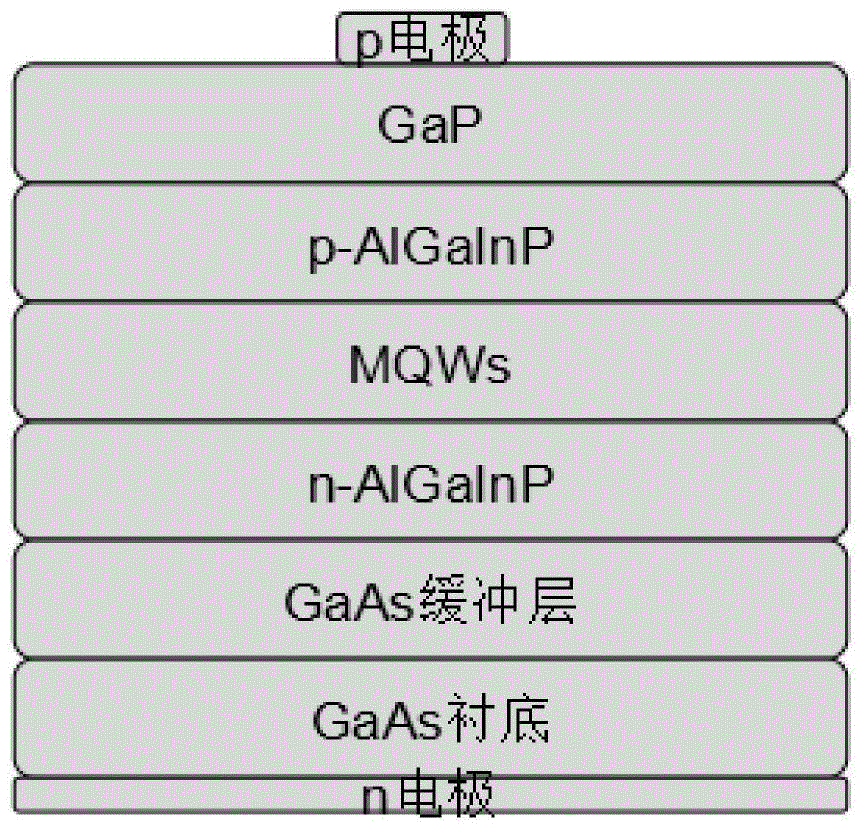AlGaInP quaternary-system LED gallium phoshpide window layer coarsening method
A quaternary system, gallium phosphide technology, applied in the direction of electrical components, circuits, semiconductor devices, etc., can solve the problems of precision equipment and operator damage, achieve high practical value, reduce total reflection, and improve safety effects
- Summary
- Abstract
- Description
- Claims
- Application Information
AI Technical Summary
Problems solved by technology
Method used
Image
Examples
Embodiment 1
[0023] A method for roughening the gallium phosphide window layer of an AlGaInP quaternary LED is carried out in a clean room, and the steps are as follows:
[0024] 1) Wash the AlGaInP quaternary red LED epitaxial wafer with acetone, isopropanol and deionized water in sequence, and then dry it in a nitrogen environment at 70 °C for later use;
[0025] 2) Paste the blue film on the GaP window layer of the above-mentioned dried epitaxial wafer, then place it upside down on the coater, spin-coat the photoresist on the GaAs substrate surface of the epitaxial wafer, set the rotation speed to 500r / s, and repeat the spin coating three times , each interval is half an hour to form a protective film, and the photoresist and citric acid do not react chemically, which can effectively protect the electrodes on the back;
[0026] 3) After peeling off the blue film of the above-mentioned LED epitaxial wafer, perform wet etching, and the etching solution is 10mL saturated citric acid (C 6 ...
Embodiment 2
[0032] A method for roughening the gallium phosphide window layer of an AlGaInP quaternary LED. The steps are basically the same as in Example 1, except that the etching solution in step 3) is 20 mL of saturated citric acid (C 6 h 8 o 7 ) solution and 10mL of 30wt% H 2 o 2 Mixture of solutions.
[0033] The detection results of the SEM images and light intensity images of the AlGaInP quaternary LED gallium phosphide window layer before and after wet etching are similar to those in Example 1.
Embodiment 3
[0035]A method for roughening the gallium phosphide window layer of an AlGaInP quaternary LED. The steps are basically the same as in Example 1, except that the etching solution in step 3) is 30 mL of saturated citric acid (C 6 h 8 o 7 ) solution and 10mL of 30wt% H 2 o 2 Mixture of solutions.
[0036] The detection results of the SEM images and light intensity images of the AlGaInP quaternary LED gallium phosphide window layer before and after wet etching are similar to those in Example 1.
PUM
 Login to View More
Login to View More Abstract
Description
Claims
Application Information
 Login to View More
Login to View More - Generate Ideas
- Intellectual Property
- Life Sciences
- Materials
- Tech Scout
- Unparalleled Data Quality
- Higher Quality Content
- 60% Fewer Hallucinations
Browse by: Latest US Patents, China's latest patents, Technical Efficacy Thesaurus, Application Domain, Technology Topic, Popular Technical Reports.
© 2025 PatSnap. All rights reserved.Legal|Privacy policy|Modern Slavery Act Transparency Statement|Sitemap|About US| Contact US: help@patsnap.com



